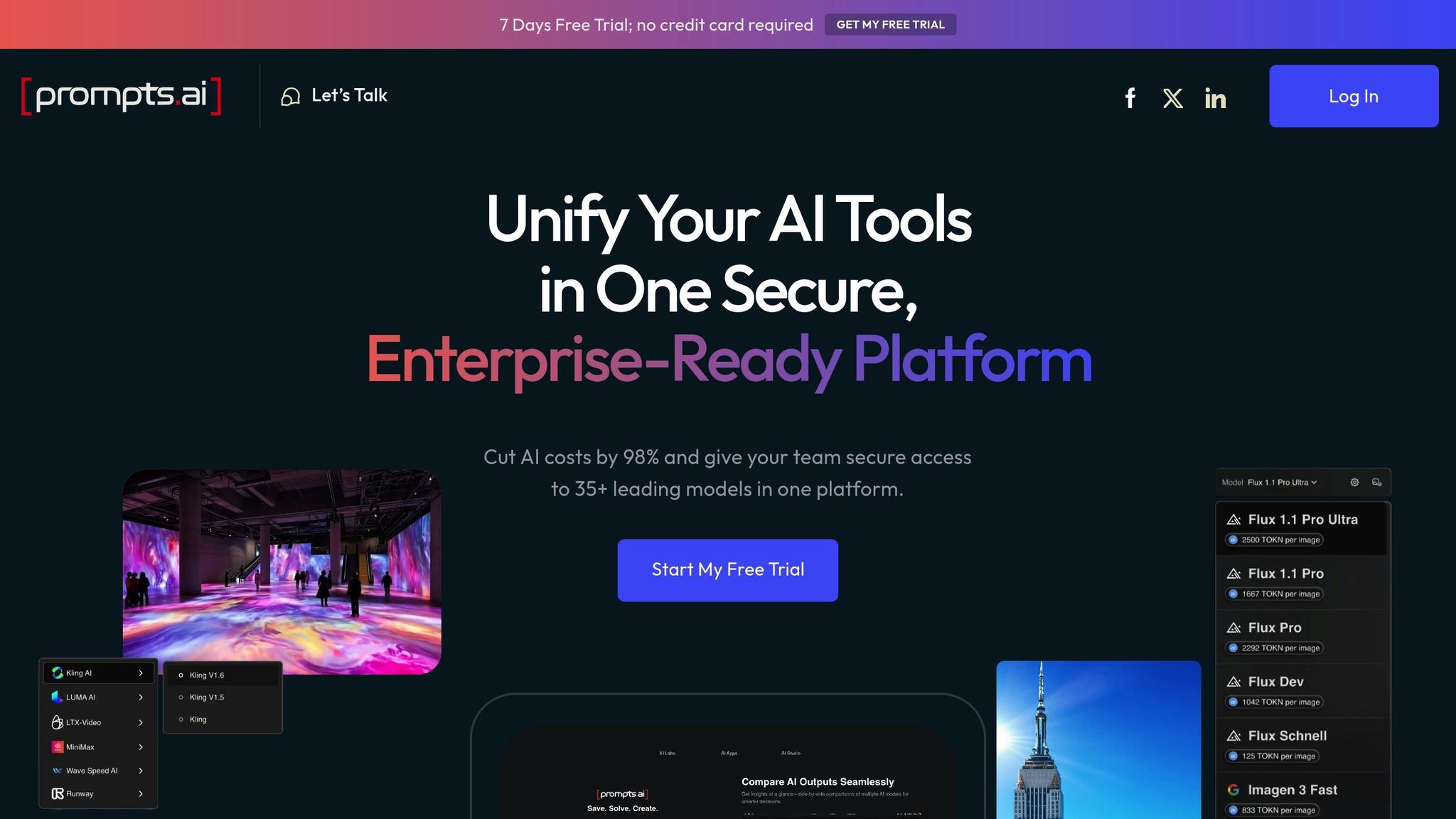
Collaboration in AI workflows has never been easier. Collaborative AI platforms are transforming how teams build, deploy, and manage AI projects. These tools centralize operations, reduce tool sprawl, and improve efficiency with features like shared prompt editing, real-time collaboration, and integrated version control. Here's a quick breakdown of the top platforms:
Each platform addresses different needs, from cost management to enterprise-grade security. Whether you're scaling AI operations or refining workflows, these solutions are designed to keep teams aligned and productive in 2025.

Prompts.ai brings together over 35 leading language models into one secure, streamlined platform, slashing AI costs by as much as 98%.
This platform redefines how teams work on AI projects by separating prompt management from coding. Its suite of tools - including threaded comments, commit messages, and no-code editors - makes it easy for both technical and non-technical team members to collaborate effectively.
Teams can co-author prompts with full version control, assigning unique identifiers and release labels like "prod" and "staging" to every change. For example, Gorgias used the platform to manage over 1,000 prompt iterations and conduct 500 evaluations in just five months. This effort automated 20% of their customer support conversations. Similarly, ParentLab enabled non-technical staff to update and deploy more than 70 prompts, saving over 400 engineering hours while speeding up the delivery of personalized AI features.
This collaborative setup seamlessly integrates with the platform’s advanced workflow orchestration capabilities.
Prompts.ai goes beyond collaboration by offering robust tools for workflow orchestration. With model-agnostic blueprints and an interactive function builder, the platform eliminates the need for complex scripting. Teams can design prompt pipelines that break down intricate tasks into manageable steps, where the output from one step feeds directly into the next.
"Prompt orchestration is more than a technical tactic; it's a thoughtful approach to AI design that acknowledges the complexity of real-world problems and the need for dependable solutions."
The platform also supports dynamic routing and A/B testing, allowing teams to direct different user segments to specific prompt versions without altering code. Automated regression and evaluation pipelines ensure that updates won’t disrupt existing workflows. For instance, Meticulate scaled a sophisticated LLM pipeline from zero to 1.5 million requests in just 24 hours during a viral launch. The platform’s monitoring tools ensured uptime and quickly resolved any issues under heavy demand.
With these workflows in place, the platform’s extensive model support further boosts operational efficiency.
Prompts.ai simplifies model management by providing access to over 35 top-tier AI models. Teams can compare model performance side by side, ensuring they choose the best option for each task without toggling between multiple tools. This comprehensive model access has yielded impressive results - Ellipsis reduced debugging time by 90% while scaling to handle over 500,000 requests and processing 80 million tokens daily.
The platform includes a built-in FinOps layer that tracks every token and optimizes costs in real time. Teams gain complete visibility into usage patterns, spending, and performance metrics tied directly to business outcomes. The pay-as-you-go TOKN credit system eliminates subscription fees, aligning costs with actual usage. Real-time cost controls and transparent analytics allow organizations to scale AI operations without worrying about budget surprises. This lets teams focus on innovation and measurable results, rather than unexpected expenses.
Building on the strengths of Prompts.ai, another standout option for managing AI workflows is Orkes, a platform designed to ensure reliability and seamless integration. Orkes focuses on creating durable AI applications, addressing the critical need for workflows that can continue uninterrupted, even in the face of unexpected failures.
Orkes specializes in crafting and deploying distributed workflows that bring together various AI components into one cohesive system. These components include AI models, prompt templates, vector databases, third-party services, and APIs. By unifying these elements, organizations can design robust AI workflows that span multiple systems while maintaining high standards of reliability and performance. One of Orkes' key features is its ability to resume workflows from the exact point of failure, eliminating the need for manual intervention and ensuring smooth operations.
Orkes takes a flexible approach to model integration, allowing teams to use a variety of large language models and AI services tailored to their specific workflow requirements. Its prompt template system ensures consistent management of prompts, while its vector database integrations enable direct access to essential data sources within business workflows. This adaptability makes it a valuable tool for organizations looking to streamline and optimize their AI processes.
Building on Orkes' strong foundation, Platform C delivers a powerful suite of tools that transform AI workflow management by prioritizing seamless team collaboration and robust security measures.
Platform C simplifies teamwork by enabling synchronized editing, allowing multiple users to collaborate on AI workflows without running into conflicts. Its security framework is designed with enterprises in mind, featuring role-based access controls, detailed audit trails, and compliance with stringent regulatory standards. Teams can assign specific permissions to different parts of a workflow, ensuring sensitive models and data stay secure while maintaining the flexibility needed for effective collaboration.
This platform shines in managing complex workflows, thanks to its visual pipeline builder and automated dependency tools. Users can link multiple AI models, add conditional logic, and set up error-handling processes - all without needing to write code. Its model-agnostic design supports integration with a wide range of AI services, enabling organizations to maximize their current AI resources while easily expanding capabilities. Additionally, the intelligent caching system cuts latency by up to 60% for frequently used workflows, ensuring smoother operations.
Platform C has proven its value in enterprise settings, helping organizations achieve a 40% faster time-to-market for AI-driven features and reducing workflow maintenance efforts by 75%. Its monitoring dashboard offers real-time data on workflow performance, resource usage, and team productivity, allowing businesses to fine-tune their AI operations with actionable insights. This combination of speed, efficiency, and transparency makes it a valuable tool for scaling AI initiatives across departments.
Different platforms bring distinct capabilities to the table when it comes to collaborative AI workflows, each catering to specific needs and priorities.
Take prompts.ai, for example. It integrates over 35 top-tier language models, including GPT-4, Claude, LLaMA, and Gemini. With its built-in FinOps layer and flexible pay-as-you-go TOKN credits, it allows real-time cost management and can slash AI software expenses by up to 98%, all while eliminating subscription fees. The platform also offers thorough onboarding and training to help teams standardize best practices across departments. However, its wide range of features might demand a learning curve for teams with simpler, single-model workflows. That said, its breadth of capabilities makes it a strong contender for large enterprises or organizations handling complex, multi-model AI operations.
Platform B, on the other hand, prioritizes simplicity with a user-friendly visual interface. This makes it ideal for teams aiming for quick AI deployment, particularly in areas like marketing and content creation. While its ease of use is a big plus, it has a more limited selection of integrated language models and less transparent cost management features. As a result, it’s better suited for teams with straightforward and focused AI needs.
Meanwhile, Platform C stands out for its dedication to security and compliance, offering robust controls and efficient workflow management. This makes it an excellent option for organizations in regulated industries. However, its real-time collaboration features might not meet the expectations of fast-paced teams that require seamless simultaneous editing.
| Platform | Key Strengths | Primary Limitations | Best Fit |
|---|---|---|---|
| prompts.ai | Access to 35+ models, up to 98% cost savings, strong governance | Steeper learning curve for simpler workflows | Large enterprises with diverse AI needs |
| Platform B | Easy-to-use visual interface, quick workflow setup | Limited model integration, less transparent costs | Teams focused on marketing and content tasks |
| Platform C | Emphasis on security and compliance, efficient workflows | Collaboration tools less suited for real-time edits | Regulated industries prioritizing security |
This overview provides a snapshot of each platform’s strengths and limitations, offering a foundation for selecting the best fit based on your organization’s priorities. The next section will delve into tailored recommendations to help refine your decision-making process.
Choose an AI platform that aligns with your team's goals and operational demands. The ideal solution should effectively combine strong collaboration tools, cost management, and the ability to scale - qualities that make prompts.ai an excellent contender.
For organizations requiring advanced orchestration, prompts.ai stands out. It provides access to over 35 top-tier models and incorporates a built-in FinOps layer, enabling cost reductions of up to 98%. The platform’s pay-as-you-go TOKN credits remove the burden of recurring subscription fees, offering clear and predictable cost management. This is especially critical for enterprises managing intricate workflows.
Prioritize features that address collaboration, cost control, and workflow efficiency. Tools like real-time co-editing, shared prompt logic, and usage-based pricing offer practical advantages that can streamline operations and improve productivity.
Plan for the future: select a platform designed to grow alongside your AI initiatives. Whether it’s accommodating more team members or meeting new compliance standards, prompts.ai provides a secure and scalable environment that fosters progress and delivers measurable outcomes.
Prompts.ai transforms how teams work together, simplifying collaboration and boosting workflow efficiency. Its platform allows teams to co-author prompts, organize shared logic, and monitor usage with ease, all in one place designed to make teamwork effortless.
Key features like real-time co-editing, built-in version control, and user-specific tracking help teams cut down on coordination time, streamline repetitive tasks, and channel their energy into creative problem-solving. Whether it’s for cross-functional projects, marketing initiatives, or internal operations, Prompts.ai empowers teams to achieve more while working smarter together.
Prompts.ai makes working together on complex AI workflows straightforward and efficient. With tools like shared prompt logic, real-time co-editing, multi-user permissions, and integrated version control, teams can collaborate smoothly while staying organized and in control.
The platform’s user-friendly drag-and-drop interface and centralized workspace allow teams to co-create prompts, oversee AI agents, and monitor progress with ease. It’s an ideal solution for dynamic teams aiming to develop, refine, and launch AI-powered projects without being bogged down by technical hurdles.
The pay-as-you-go TOKN credit system offered by prompts.ai gives teams a clear, real-time view of their token usage, making cost tracking and management straightforward. With the ability to monitor usage as it happens, teams can swiftly tweak workflows or refine processes to avoid overspending.
This system is designed to be flexible, ensuring you’re charged only for what you use. It’s an efficient way to cut down on waste and stay within budget - perfect for teams tackling fast-moving, AI-driven projects.


